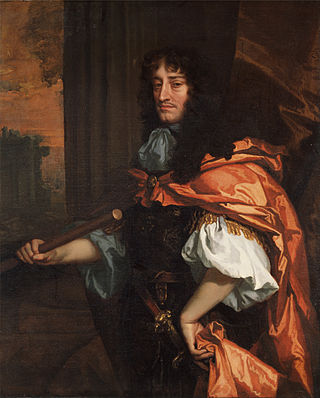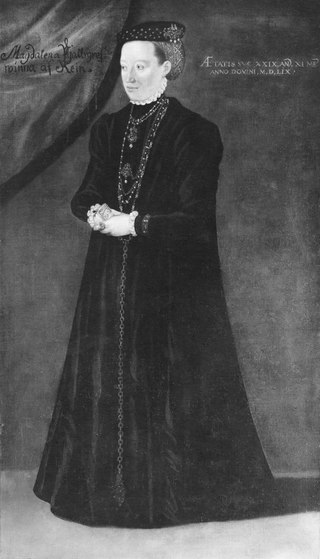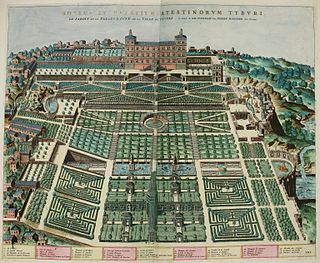
The Electoral Palatinate or the Palatinate, officially the Electorate of the Palatinate, was a constituent state of the Holy Roman Empire. The electorate had its origins under the rulership of the Counts Palatine of Lotharingia in 915; it was then restructured under the Counts Palatine of the Rhine in 1085. From 1214 until the Electoral Palatinate was merged into the Kingdom of Bavaria in 1805, the House of Wittelsbach provided the Counts Palatine or Electors. These counts palatine of the Rhine would serve as prince-electors from "time immemorial", and were noted as such in a papal letter of 1261; they were confirmed as electors by the Golden Bull of 1356.

Baroque painting is the painting associated with the Baroque cultural movement. The movement is often identified with Absolutism, the Counter Reformation and Catholic Revival, but the existence of important Baroque art and architecture in non-absolutist and Protestant states throughout Western Europe underscores its widespread popularity.

Prince Rupert of the Rhine, Duke of Cumberland, was an English-German army officer, admiral, scientist, and colonial governor. He first rose to prominence as a Royalist cavalry commander during the English Civil War. Rupert was the third son of the German Prince Frederick V of the Palatinate and Elizabeth, eldest daughter of King James VI and I of Scotland and England.

Elizabeth Stuart was Electress of the Palatinate and briefly Queen of Bohemia as the wife of Frederick V of the Palatinate. The couple's selection for the crown by the nobles of Bohemia was part of the political and religious turmoil setting off the Thirty Years' War. Since her husband's reign in Bohemia lasted over one winter, she is called "the Winter Queen".

Frederick V was the Elector Palatine of the Rhine in the Holy Roman Empire from 1610 to 1623, and reigned as King of Bohemia from 1619 to 1620. He was forced to abdicate both roles, and the brevity of his reign in Bohemia earned him the derisive sobriquet "the Winter King".

Baroque architecture is a highly decorative and theatrical style which appeared in Italy in the early 17th century and gradually spread across Europe. It was originally introduced by the Catholic Church, particularly by the Jesuits, as a means to combat the Reformation and the Protestant church with a new architecture that inspired surprise and awe. It reached its peak in the High Baroque (1625–1675), when it was used in churches and palaces in Italy, Spain, Portugal, France, Bavaria and Austria. In the Late Baroque period (1675–1750), it reached as far as Russia, the Ottoman Empire and the Spanish and Portuguese colonies in Latin America. In about 1730, an even more elaborately decorative variant called Rococo appeared and flourished in Central Europe.
Isaac de Caus (1590–1648) was a French landscaper and architect. He arrived in England in 1612 to carry on the work that his brother Salomon de Caus had left behind. His first known work in England was a grotto that Caus designed in 1623 located in the basement of Inigo Jones's Banqueting House. He is noted for his work at Wilton House and Lincoln's Inn.

Heidelberg Castle is a ruin in Germany and landmark of Heidelberg. The castle ruins are among the most important Renaissance structures north of the Alps.

Salomon de Caus was a French Huguenot engineer, once (falsely) credited with the development of the steam engine.

Hendrick de Keyser was a Dutch sculptor, merchant in Belgium bluestone, and architect who was instrumental in establishing a late Renaissance form of Mannerism changing into Baroque. Most of his works appeared in Amsterdam, some elsewhere in the Dutch Republic. He was the father of Pieter and Thomas de Keyser and Willem, and the uncle of Huybert de Keyser, who became his apprentices and all involved in building, decoration and architecture.

Herrad of Landsberg was a 12th-century Alsatian nun and abbess of Hohenburg Abbey in the Vosges mountains. She was known as the author of the pictorial encyclopedia Hortus deliciarum.

Hortus conclusus is a Latin term, meaning literally "enclosed garden". Both words in hortus conclusus refer linguistically to enclosure. It describes a type of garden that was enclosed as a practical concern, a major theme in the history of gardening, where walled gardens were and are common. The garden room is a similar feature, usually less fully enclosed.

The Paladins, also called the Twelve Peers, are twelve legendary knights, the foremost members of Charlemagne's court in the 8th century. They first appear in the medieval chanson de geste cycle of the Matter of France, where they play a similar role to the Knights of the Round Table in Arthurian romance. In these romantic portrayals, the chivalric paladins represent Christianity against a Saracen (Muslim) invasion of Europe. The names of the paladins vary between sources, but there are always twelve of them led by Roland. The paladins' most influential appearance is in The Song of Roland, written between 1050 and 1115, which narrates the heroic death of Roland at the Battle of Roncevaux Pass.

Wenceslas Cobergher, sometimes called Wenzel Coebergher, was a Flemish Renaissance architect, engineer, painter, antiquarian, numismatist and economist. Faded somewhat into the background as a painter, he is chiefly remembered today as the man responsible for the draining of the Moëres on the Franco-Belgian border. He is also one of the fathers of the Flemish Baroque style of architecture in the Southern Netherlands.

Johann Ernst of Nassau-Weilburg was an Imperial Generalfeldmarschall, from 1675 to 1688 Count and from 1688 until his death Prince (Fürst) of Nassau-Weiburg.

Jacques Fouquier, Jacques Fouquières or Jacob Focquier was a Flemish landscape painter. After training in Antwerp he worked in various places where he often obtained appointments as a painter to the court including that of the French kings. He earned great success and a very high reputation during his lifetime and was even referred to as the 'Flemish Titian'. Very few of his paintings have been preserved. His work was influential in his time and was widely circulated thanks to reproductions by various contemporary engravers.

Anna of Hesse was a princess of Hesse by birth and marriage Countess Palatine of Zweibrücken.

The Baroque garden was a style of garden based upon symmetry and the principle of imposing order on nature. The style originated in the late-16th century in Italy, in the gardens of the Vatican and the Villa Borghese gardens in Rome and in the gardens of the Villa d'Este in Tivoli, and then spread to France, where it became known as the jardin à la française or French formal garden. The grandest example is found in the Gardens of Versailles designed during the 17th century by the landscape architect André Le Nôtre for Louis XIV. In the 18th century, in imitation of Versailles, very ornate Baroque gardens were built in other parts of Europe, including Germany, Austria, Spain, and in Saint-Petersburg, Russia. In the mid-18th century the style was replaced by the less geometric and more natural English landscape garden.

Anne Sutton (1589–1615) was an English lady-in-waiting who was a companion of Elizabeth Stuart, Queen of Bohemia. She was the daughter of Edward Sutton, 5th Baron Dudley and Theodosia Harington. Sutton was known as "Mrs Anne Dudley" or "Mistress Dudley" although "Sutton" was the family surname. Elizabeth of Bohemia called her "Nan Duddlie".

A Renaissance garden is a garden or park created in the era and style of the Renaissance. Because the first such gardens originated in Italy, they are sometimes called Italian gardens. However, gardens made later in Germany, France, or England might have had some differences compared to the original Italian gardens.






















